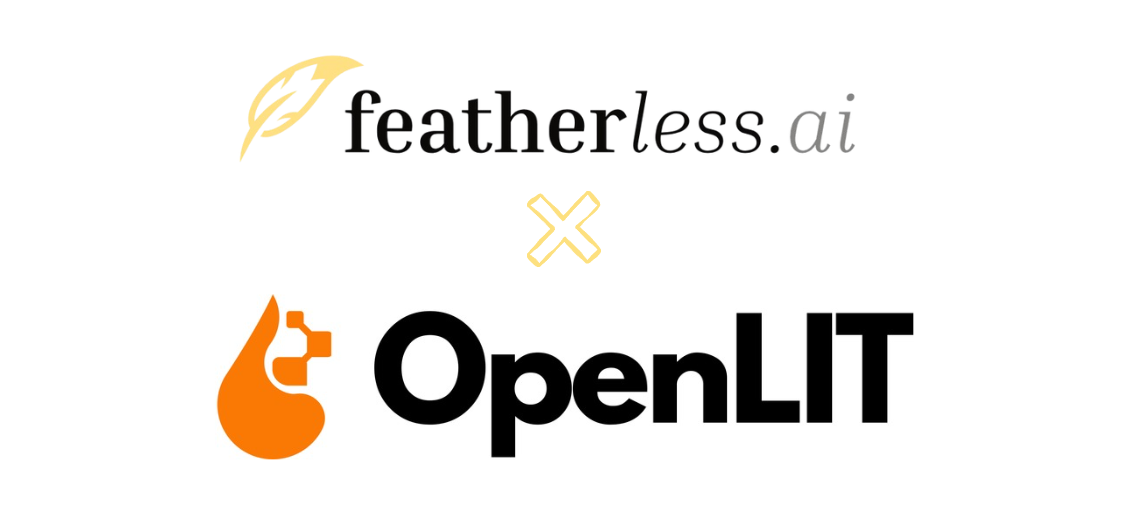LLM Observability: How Featherless + OpenLIT Simplifies AI Monitoring.
Log chats, prompts and completions using OpenLIT

As AI technology continues to grow, the need for accurate, reliable, and scalable generative AI applications becomes increasingly important. However, building these applications is only part of the solution. Monitoring them is crucial to ensure they run smoothly and meet performance expectations. This blog post explores why monitoring is essential for generative AI applications and how Featherless integrates with the OpenTelemetry-native tool, OpenLIT, to provide developers with seamless, one-click observability.
Why Monitoring Is Important for Generative AI Applications.
Ensure Application Performance
Monitoring helps you keep an eye on the performance of your AI applications. You can track the response times, understand bottlenecks, and see how the system behaves under different loads. This ensures that users enjoy a smooth and fast experience.
Debugging and visibility
Without proper tracing, diagnosing issues is nearly impossible. Tracing allows us to see each decision made by the AI Agents, the information it accessed, and the reasons behind its actions. Tracing provides a clear, cohesive view of all interactions, from database calls to web requests
Maintain Accuracy and Reliability
Monitoring allows you to ensure the outputs remain accurate and consistent. You'll be able to spot anomalies quickly and make necessary adjustments before they impact users.
Optimize Resource Usage
AI applications often require significant computing resources. Through monitoring, you can track resource utilization, identify areas where resources might be wasted, and optimize to save costs and improve efficiency.
Enhance User Experience
By monitoring user interactions and feedback, you can gain insights into how users engage with your application. This can drive improvements and innovation in features and capabilities to better serve your customers.
Ensure Scalability
As demand grows, your application must scale accordingly. Monitoring helps identify when it's time to scale and provides insights into how to do so effectively without compromising performance.
Why OpenTelemetry for monitoring?
OpenTelemetry is an open standard that ensures it remains updated with the best practices and technologies, thanks to contributions from a worldwide community of developers and experts. This guarantees that your monitoring infrastructure is built on robust, evolving standards.
As a vendor-neutral solution, OpenTelemetry offers the flexibility to choose or switch between different monitoring backends without being locked into a specific vendor’s ecosystem. This flexibility reduces risks and allows you to tailor your observability stack to your needs without compatibility concerns.
Furthermore, OpenLIT is built on OpenTelemetry and can easily transmit traces and metrics to popular tools like Grafana and New Relic. This seamless integration allows you to incorporate OpenLIT into your existing monitoring setup with one line of code, ensuring an efficient and streamlined observability process.
How Featherless Integrates with OpenLIT for Monitoring
Featherless provides robust support for building generative AI applications, but when it comes to monitoring, it seamlessly integrates with OpenLIT. OpenLIT is an OpenTelemetry-native tool that simplifies the observability setup process. Here's how you can leverage this integration to monitor your AI applications effortlessly.
Step 1: Install the OpenLIT SDK
To start, install the OpenLIT SDK using the following shell command:
pip install openlitStep 2: Instrument your application
Integrate OpenLIT into your application with just two lines of code
import openlit
openlit.init()The OpenLIT SDK automatically logs all OpenTelemetry traces and metrics to the console (terminal), which is useful for the initial stages and debugging.
To store traces and metrics for further analysis, you can deploy the OpenLIT stack as described in the official OpenLIT documentation. Once OpenLIT is up and running, configure your OpenTelemetry endpoint by setting:
export OTEL_EXPORTER_OTLP_ENDPOINT="YOUR_OPENLIT_URL:4318"If you prefer to use a different observability platform, such as Grafana or another vendor, you can easily configure your system to send data there instead. For detailed configuration instructions, please refer to the OpenLIT documentation.
Detailed Example: Monitoring an AI application
Here's an example using the OpenAI SDK to showcase end-to-end monitoring:
import os
from openai import OpenAI
import openlit
# Set your API key
FEATHERLESS_API_KEY= "your-api-key-here" # Replace with actual API key
# Alternatively, you can set it as an environment variable
# FEATHERLESS_API_KEY = os.getenv("FEATHERLESS_API_KEY")
openlit.init()
client = OpenAI(
base_url="https://api.featherless.ai/v1",
api_key=f"{FEATHERLESS_API_KEY}",
)
response = client.chat.completions.create(
model='meta-llama/Meta-Llama-3.1-8B-Instruct',
messages=[
{"role": "system", "content": "You are a helpful assistant."},
{"role": "user", "content": "Hello! Tell me the benefits of monitoring my AI Agentic applications"}
],
)
Step 3: Monitor and Optimize
The collected traces and metrics offer a comprehensive overview of system performance across eight crucial areas:
Total Successful Requests
Request Duration Distribution
Request Rates
Usage Tokens
Top Used LLM Models
LLM Requests by Provider and Environment
Prompt and Completion Monitoring
Automatic Evaluation scoring
These metrics are invaluable for identifying peak usage times, latency issues, rate limits, and resource allocation. They facilitate performance tuning and cost management. For instance, prompt and completion monitoring allows people to analyze and monitor prompts and responses over time, leading to improvements in prompt structuring and response accuracy.
By providing a detailed breakdown of LLM performance, these metrics ensure consistent operation across different environments, help in budgeting, and aid in troubleshooting issues. Ultimately, this optimizes overall system efficiency.
Next Steps
Monitoring is an integral part of developing and maintaining generative AI applications. It ensures that your applications are running smoothly, reliably, and efficiently. Integrating Featherless with OpenLIT provides a powerful combination of tools that offer robust, one-click observability. With everything set up, you're free to focus on innovation and delivering great user experiences.
→ Featherless OpenLIT Integration docs